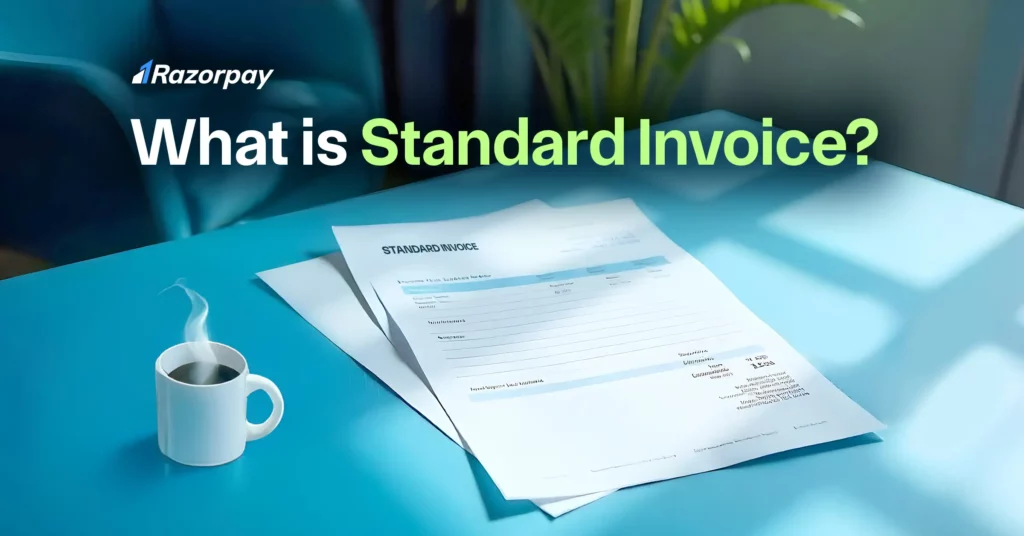Table of Contents
What is a Standard Invoice?
A standard invoice is a document issued by a seller or service provider to a buyer that outlines the details of a product or service sold and the payment details. It’s a formal request to a customer for payment for the goods and services provided.
Invoicing is not only a way to record and receive payments but also plays a key role in building a strong professional relationship between the seller and the buyer. A standard invoice acts as proof of the purchase or sale of goods or services, which is crucial for accounting and tracking your business activities.
Components of a Standard Invoice
A standard invoice consists of several key components that provide essential information about the transaction. Here’s a breakdown of each element:
1. Header
The header includes “Invoice” prominently displayed, conveying the document’s purpose.
2. Invoice Number
Each invoice is issued a unique identification for tracking and reference objectives. This helps both the vendor and the buyer keep their records organized.
3. Invoice Date
The date when the invoice is issued. This helps to create invoice payment and record-keeping timelines.
4. Due Date
It is the date by which the payment should be made. It ensures that both parties are informed of the payment schedules.
5. Seller’s Details
This includes information about the seller, including your business name, address, and contact details. It also identifies who is issuing the invoice.
6. Buyer’s Details
This includes information about the buyer, including their name, address, and contact details. It also specifies who is responsible for making the payment.
7. Description of Goods/Services
A detailed list of the products or services provided, including quantity and unit prices. This clarifies what the buyer is being charged for.
8. Subtotal
The total cost of the goods or services before additional charges, such as taxes or discounts. It provides a clear breakdown of the charges.
9. Taxes
Any applicable taxes added to the subtotal. This is required for tax compliance and to advise the buyer of additional expenses.
10. Discounts
Discounts are reductions in the subtotal given as promotions or incentives. This lowers the total amount due.
11. Shipping or Additional Fees
Costs for shipping or other services that may apply. This makes sure that all costs associated with the transaction are clearly defined.
12. Total Amount Due
This is the final amount the buyer has to pay, including the subtotal, discounts, taxes, and any additional fees. It represents the complete financial obligation.
13. Payment Terms
The payment terms and conditions, including accepted payment methods and late payment penalties, establish clear expectations for both parties.
14. Footer
The footer may include additional notes, such as thank-you messages or reminders about payment methods. It usually improves customer interactions and provides additional information.
Benefits of Using Standard Invoice Formats
Here are some advantages of maintaining a consistent format for standard invoices:
- It enables businesses to issue bills to clients with minimal effort.
- It serves as a reminder to clients of the work completed, helping businesses collect accurate and timely payments.
- It acts as an effective record-keeping tool, allowing businesses to organise their accounts efficiently.
- It helps businesses stay on top of their finances and manage their working capital effectively.
- It ensures compliance with tax reporting requirements.
- It facilitates a smooth transition to digital invoicing.
Example Formats of Standard Invoice
There are several formats to choose from, and you may customise them to match your individual needs. Below are some examples of generated standard e-invoice formats or styles:
Detailed Format of a Standard Invoice
Here’s a breakdown of the key components of a standard invoice format:
Top Section (Business and Client Details)
The top section of the invoice should clearly display the following:
- Business name
- Logo
- Contact information includes address, phone number, and website.
Below the seller’s details, include the client’s name, address, and contact person (if applicable). A format similar to that used in the client’s business correspondence might help ensure consistency.
Middle Section (Invoice Details)
The middle section starts with the label “INVOICE” to state the document’s purpose. Directly below, include the unique invoice reference number and the issue date. The invoice number is useful for tracking payments and keeping orderly records.
Next, provide an itemised list of the goods or services sold, specifying quantities, unit pricing, and descriptions. Make sure that the formatting is clear and easy to understand. If necessary, provide any relevant details, such as purchase order or batch numbers for individual items.
Bottom Section (Payment Information)
In the bottom area, describe the payment terms, including the due date and accepted payment methods. Some common terms include “Net 30” (payment payable within 30 days) and “Due upon receipt”. Specify any late fees or penalties for delayed payments.
Provide the total amount due, broken down into subtotal discounts, taxes, and additional fees (if any). This helps the buyer understand the complete financial obligation.
Lastly, include any notes, special instructions, or terms and conditions related to the transaction. This could cover return policies, warranties, or any other relevant information.
Best Practices for Creating a Standard Invoice
Maintaining positive customer relations and ensuring payments are made on time depend on producing professional and efficient invoices. Here are some best practices to consider:
Use Invoice Software
Using accounting or invoicing software may significantly streamline and automate the process of generating invoices. These tools frequently include pre-designed templates, automated calculations, and payment tracking, which lowers the possibility of errors and saves valuable time.
Regularly Review and Update Invoice Templates
It’s essential to regularly check and update your invoice templates to ensure they comply with legal standards and your company’s current needs. This approach gives your billing process clarity and consistency while preserving professionalism and guaranteeing compliance with any modifications to tax legislation or industry standards.
Include Clear Payment Instructions
If you want clients to pay on time, it’s crucial to provide clear and simple payment instructions. Specify the acceptable payment methods, the due dates for payments, and any late fees. Being transparent promotes clarity and facilitates a more seamless transaction procedure, eventually improving your company’s cash flow.
Typical Business Situations Where Standard Invoices are Used
Standard invoices are widely used in the business world to request payment for goods or services provided. Below are some real-life examples of situations where standard invoices are commonly used:
- A graphic designer who has completed a logo design for a client sends an invoice outlining the hours worked and the agreed rate.
- After delivering handcrafted jewelry to a local store, a supplier sends an invoice for the total value of the items supplied.
- A management consultant who has completed a month-long project for a corporate client invoices for the hours worked at the previously agreed-upon rate.
- An online retailer includes an invoice with a delivered package, showing the items purchased, their prices, any shipping charges, and the total amount owed.
- At the end of the month, a water utility company sends households an invoice for the water consumed.
- A plumber who repaired a leaky faucet sends an invoice with details of the labor cost and the price of any replacement parts.
- A law firm working on a civil case sends a monthly invoice to the client, breaking down the hours worked by attorneys, paralegals, and other staff.
- A landlord sends a monthly rental invoice to a tenant for the leased commercial space.
- A company offering monthly subscription boxes invoices its subscribers each month, detailing the cost of the box and any extra fees.
- After a patient visits a clinic, the healthcare provider issues an invoice covering the consultations, tests, and any treatments or medications provided.
In all these examples, the standard invoice typically includes key details like the names and addresses of the seller and buyer, invoice date, description of the goods or services, total amount due, payment terms, and more.
The Standard Invoice Compared to Other Invoice Types
While standard invoices are often used in a variety of business settings, there are a few more types of invoices that serve different purposes. Here’s a comparison of standard invoices with various other invoice types:
Proforma Invoice vs. Standard Invoice
Proforma Invoice
A proforma invoice is a preliminary document that estimates costs before goods or services are provided and acts as a quotation.
Standard Invoice
In contrast, a standard invoice is issued after the delivery of goods or services and serves as a formal payment request, making it legally binding.
Interim Invoice vs. Standard Invoice
Interim Invoice
An interim invoice is issued for partial payments during long-term projects, allowing you to receive payments incrementally rather than waiting until the project is complete.
Standard Invoice
In comparison, a standard invoice requires payment for the total amount due after all services or goods have been delivered.
Recurring Invoice vs. Standard Invoice
Recurring Invoice
A recurring invoice is generated at regular intervals for ongoing services, such as subscriptions or memberships, ensuring consistent cash flow.
Standard Invoice
On the other hand, a standard invoice is typically issued for one-time transactions, detailing the total payment due for specific goods or services rendered.
Commercial Invoice vs. Standard Invoice
Commercial Invoice
A commercial invoice is specifically issued for international trades and provides detailed information necessary for clearance, including the value of goods and shipping details.
Standard Invoice
In contrast, standard invoices are used primarily for domestic transactions and do not necessarily include any customs-related information.
Value-Based Invoice vs. Standard Invoice
Value-Based Invoice
A value-based invoice charges your clients based on the perceived value of the service rather than the cost of inputs or time spent.
Standard Invoice
This differs from a standard invoice, which typically itemises services or products based on their price, providing a straightforward billing approach.
Why is Choosing the Right Invoice Format Crucial for Businesses?
When selecting the best invoice template for your business, it’s essential to consider the services or products you provide and your company’s objectives. Think about the goods and services you offer, how frequently you want to bill your customers, the payment methods you accept, and how you manage your accounts.
The key to choosing the right invoice format is to find one that enables you to bill for your products and services while ensuring timely payments.
Practical Tips for Selecting an Invoice Format:
- Always select a format that aligns with your billing methods (hourly, fixed-price, subscription, etc.)
- Ensure your format is easy to customise with your branding elements (logo, colours, fonts.)
- Consider the level of detail required by your clients (simple vs. itemised.)
- Opt for a format that automatically calculates totals, taxes, and discounts to minimise errors.
- Select a format that is easy to generate and send, whether through invoicing software or templates.
Conclusion
Maintaining professionalism, guaranteeing timely payments, and billing effectively all depend on having a standard invoice that is appropriately organised. You can reduce your accounting procedures and build customer confidence by integrating clear details, branding, and legal requirements. Thus, always choose the proper invoice format that not only simplifies your transactions but also supports better financial management and compliance.
Related Read: How to Write a Professional Invoice Email
Frequently Asked Questions
1. What are standard invoice terms?
“Standard invoice terms” refer to the guidelines defining when and how payments will be made. Common terms include “Due upon receipt,” which indicates payment must be made immediately, and “Net30,” which indicates payment is due within 30 days of the invoice date. Clearly defined conditions assist in managing expectations and promoting timely payments between you and your customers.
2. What should be on a standard invoice?
A standard invoice should include essential elements such as the seller’s and buyer’s contact information, invoice number, date, itemised list of goods or services, subtotal, applicable taxes, discounts, total amount due, and payment terms. Including clear payment instructions can also enhance the invoice’s effectiveness.
3. What is the standard invoice time?
Standard invoice time refers to the duration from when an invoice is issued until the payment is due, as specified in the invoice terms and conditions. This timeframe can vary based on your agreement with the seller, with common terms being Net 15, Net 30, or Net 60 days.
4. How do I create a standard invoice?
To create a standard invoice,
- Start by choosing an appropriate template or using invoicing software.
- Include your business name, logo, and contact details at the top, followed by the client’s information, invoice number, and date.
- Itemise the goods or services provided, calculate the total amount due, and clearly specify payment terms before sending it to the client.
5. Why is it important to include payment terms on an invoice?
Including payment terms on an invoice is important since it clarifies when the payment is expected and outlines acceptable payment methods. This helps prevent misunderstandings and encourages timely payments, which is crucial for maintaining a healthy cash flow.
6. Can I use a standard invoice template for different clients?
Yes, you can use a standard invoice template for different types of clients, but it’s important to always customise it for each transaction. Make sure to update your client’s name, contact information, and any specific details related to the goods or services provided. Customising the template ensures professionalism and accuracy, helping to maintain strong client relationships.



